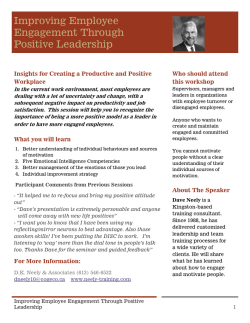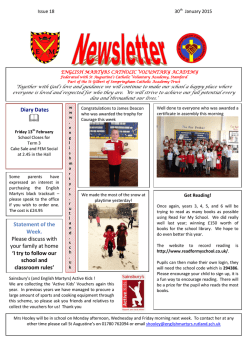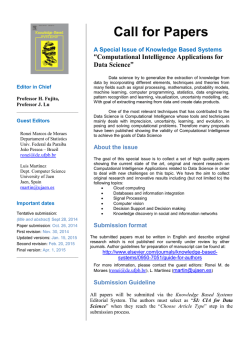
Cultivate by Morag Barrett – Read Chapter 1
Chapter 1 the people side of business Lots of people want to ride with you in the limo, but what you want is someone who will take the bus with you when the limo breaks down. « Oprah Winfrey » 2 CULTIVATE: THE POWER OF WINNING REL ATIONSHIPS W e’ve all worked with people we find irritating: the person with an ego so huge the office has to install double doors to accommodate his or her super-sized head; the colleague who just can’t stop talking about anything but work; or the poor soul who’s desperate to share complaints every day. One approach might be to avoid these people at all costs, but what if they’re your boss or your peer? You’ll need to spend IQ a considerable amount of time in meetings with them, or working side-by-side, and your success will be intertwined with theirs. Technical Working with people who drive you nuts is exhausting and People can, unfortunately, impact your attitude and performance. Emotions are infectious. Relationships are emotional. Think about it. Have you ever walked into a room and just sensed, without talking to anyone, that something was up? Our emotional intelligence enables us to pick up on these clues, discriminate between them, and use this information to inform our thinking and actions to impact our behavior. Being the smartest person in the room (IQ) is no longer (and may never have been) enough to ensure long-term success; technical skills and knowledge only contribute part of the equation. Emotional intelligence (EQ or EI), or people skills, is as important, if not more so, than IQ. Emotional intelligence is the capacity for effectively recognizing and managing our own emotions and those of others. We can either leverage emotions to make the most of our important business and personal relationships or ignore them with potentially damaging results. In his book Working with Emotional Intelligence, Daniel Goleman1 discusses four emotional intelligence skills, grouped under two main categories: personal competence and social competence. Personal competence includes the following qualities: • Self-awareness—how accurately you can identify your emotions in the moment and understand your tendencies across time and situation. THE PEOPLE SIDE OF BUSINESS 3 • Self-management—how you use awareness of your emotions to create the behavior that you want. Once you have begun to master yourself, you can then move on to the qualities of social competence: • Social awareness—how well you read the emotions of other people. • Relationship management—how you use the first three emotional intelligence skills to manage your interactions with other people. When I am working with teams, I will ask participants to identify three colleagues, bosses, peers, or subordinates, they would jump at the chance to work with again. We then explore what made these people memorable. Certain characteristics are mentioned again and again: • They saw me as an individual; they cared about me. • They connected with me as a person. • They made time for me and listened to my ideas and suggestions. • They gave me constructive feedback. • They made me feel valued. • They challenged me to deliver outstanding results. What stands out is that the majority of the qualities are interpersonal—about how the person interacted with them, as well as the values he or she demonstrated. While we may recall how smart someone was, what people remember is the ability to connect with someone as a person, as a human being, and not simply as an employee, functional expert, or vendor. If It Ain’t Broke Many of us understand the philosophical importance of relationships but struggle to put it into action. I get plenty of agreement with these early concepts. However, when I ask, “How much time are you investing in cultivating winning relationships?” very few can say they devote deliberate effort. 4 CULTIVATE: THE POWER OF WINNING REL ATIONSHIPS Relationships are assumed to be effective until proven otherwise. Neutral relationships are valued as positive, when in fact the opposite is true. Focus is on the task at hand, the “what needs to be done,” and little or no time is devoted to the people side of “how we will get the task done.” Success is measured in terms of individual results and individual contribution. Unfortunately, this approach actually sabotages our business goals! The “me first” attitude is not surprising when you consider that our educational system reinforces this mindset. From the time you begin school, all the way through high school and college, there’s a focus on graduating in the top X percent of your class by outperforming enough of your classmates. It’s all about individual effort, and ultimately, individual success. Even where group projects are assigned, there is little time devoted to teaching effective team collaboration. So few have been taught the skills needed to work well with others, to hear alternative points of view, and to discuss differing viewpoints to increase understanding. When we move from school to the workplace, this individualistic approach continues. We spend most of our time early in our careers developing our technical expertise, which is typically how we (and others) assess our value within an organization. As you progress through your career, the quality of your relationships has a greater impact on your success than your individual accomplishments. The ability to achieve results with others is your most valuable skill. An inability to work well with others invariably leads to the stalling of careers or, even worse, implosion. An inability to “play well with others” will damage your reputation and long-term career success, no matter how many letters you have after your name, how many years of experience you have, or what your title is. Organizations are full of examples of people who were technically competent and thus promoted up the ladder to manage others. Many times, these individuals are not provided with coaching, support, or training to understand that managing others requires a whole new set of skills—and a new mindset! As a result of this “sink or swim” approach to leadership development, many of these individuals self-destruct. No one wanted them on the team, or they were so quiet that no one recognized the value of what they brought to the table. This is an example THE PEOPLE SIDE OF BUSINESS 5 of the “Peter Principle” or “Sheldon Syndrome”—a high IQ with low emotional intelligence. Book Smart not People Smart Mark was used to being the smartest guy in the room. He was always quick to volunteer his opinion, first to speak, and kept talking, dominating the conversation. Meetings with his peers were tense, and projects were not running smoothly. Instead of being a go-to guy, he was a go-from guy. Mark was oblivious to this. He relished the “smart” image he had built up. After all, his technical knowledge brought him the promotion to head of his department. His promotion finally revealed what his team knew: he delivered results . . . alone, at the cost of relationships across the company and within his department. Mark had known things were tense, he hadn’t realized that he was the problem. As our team shared the framework for identifying and cultivating relationships, he realized his intentions and actions were way out of sync. Through coaching, we explored ways for Mark to adjust his behavior and approach—asking questions vs. telling, allowing others to talk first before offering his opinion, spending time getting to know his critical stakeholders, and asking them what they needed from him to help them be successful. It was a rapid transformation. Relationships became more open and trusting. Mark’s mid-year review evaluation was the best he had ever received. A 360 Feedback report completed during his coaching confirmed the change in approach was reaping benefits, not just for Mark but for his colleagues too. One peer said, “He’s so much more approachable . . . he listens to others’ views . . . I feel more able to collaborate and work with him.” Why Fail? Few leaders fail because of a lack of technical ability. Leaders fail because they do not cultivate effective working relationships across the organization. They do not have the ability to influence others to get results. Think back through your own career, as you watched others rise or fail. When careers derail, it’s not usually about expertise; it’s usually 6 CULTIVATE: THE POWER OF WINNING REL ATIONSHIPS because of mismanaged relationships. Let’s be clear, knowledge of your industry is important and critical to your ability to talk credibly, anticipate problems, and contribute effectively to discussions. However, these skills are the minimum entry-level requirement that gets you a seat at the table. Your ability to build and maintain high-quality relationships will grow your success, and your team’s success, to the next level of performance. This is the game changer that will accelerate your success. You deserve to invest here! Interestingly enough, even when formal leadership development is provided, the results are not always beneficial. The American Society of Training and Development’s 2012 industry report indicated that American businesses alone spent a staggering $156 billion on employee learning and development. This is a phenomenal investment, especially when reports go on to suggest that nearly twoManagers spend between thirds of organizations report that senior 70 and 90 percent of managers are deficient in management and leadership skills and even more inditheir time working with others . . . a wasted oppor- cate that line 2managers and supervisors lack these skills . tunity if it is not coupled We teach people how to delegate, with deliberate attention project manage, and give annual reviews, to developing relationships. but we don’t teach people how to intentionally improve working relationships. According to John Kotter, the average [general] manager spends approximately 25 percent of his or her time working alone. Most spend between 70 and 90 percent of their time working with others, whether attending meetings, ad hoc gatherings, or formal employee gatherings, or responding to individual questions and requests for help.3 This is reaffirmed in the work I do with senior leaders and teams; all this interaction is a wasted opportunity without deliberate and focused attention on developing effective working relationships. In an attempt to manage schedules and the numerous demands on a leader’s time, most meetings and interactions become purely transactional processes, destined to be average and deliver average results. • • • • • • THE PEOPLE SIDE OF BUSINESS 7 Whether you are a senior leader in an organization or an individual contributor, most professional relationships fail to move beyond this mechanical arrangement. It seems to be easier that way. It’s about, “How can you help me in my current role or project?” with little attention focused on getting to know the other person, or how we can help them. This is a shortsighted approach. To cultivate a winning relationship means that we take each relationship to the next level and build a personal connection, seeking to understand what motivates the person, what fears may be holding them back, how our individual styles are similar or different, and the implications for working together to deliver an outstanding result. Without this personal connection, collaboration, candor, and healthy competition are stifled. Shared learning and warnings of impending disaster are also curtailed, and competition potentially becomes destructive. Business relationships determine business success. Social Workplace Bonds In an article, the Harvard Business Review4 found that social bonds were the major predictor of team success. The other two were “initiatives to strengthen relationships” and “leaders who invest the time to build strong relationships with their teams.” If team success (and individual success) is dependent upon social bonds, then it would follow that spending time getting to know the team members and articulating the rules of engagement for the team would be a good investment of time, right? Creating these social bonds is much easier said than done. With the advancement in technology, email has become ubiquitous, to the point of actually undermining performance! In a recent program presented by my team, leaders reported they each received several hundred emails a day. While email may be keeping leaders tied to their desktops, or with their smartphones permanently available twenty-four hours a day, it is also preventing the creation of meaningful connections and relationships at work. I’ve experienced this in a large telecommunications firm, where an egalitarian approach backfired. We were a company of cubicles. You could walk corridors but not see anyone. People used email to chat with team members twenty feet away, and we wondered why there wasn’t a real bond! 8 CULTIVATE: THE POWER OF WINNING REL ATIONSHIPS Contrast this with a working environment that was completely open: no walls, no hiding, and no excuses. Team members could simply raise their heads and talk to the person next to them. It led to a much different environment, where camaraderie and team relationships flourished. Don’t get me wrong, we still needed “quiet time” away from the hubbub of the office and a private office to hold confidential conversations when needed. I am not suggesting you start knocking down walls to build relationships (although now that I think of it—yes I am—the metaphorical walls that prevent us from getting to know the person in the next office). My experience in both of these environments shaped my creed: “Get off your butt and go talk to someone!” Even when teams get together to plan how they’ll achieve a goal, many times they simply go through the motions of creating working agreements, clarifying goals and roles, only to promptly ignore them when they get back to their desks. Time is of the essence (emails continue to demand attention). And the perception that building relationships is “soft and fluffy” leads us to undervalue the time to focus on the interpersonal side of business. I remember being told early in my finance career, “This is a business; there is no place here for emotions or personal connections.” With such a philosophy it’s little wonder that trust within teams declined and the confidence in the team leader was diminished. We all know when the rules of engagement have been broken. We sit in meetings drumming our fingers, clenching our teeth in frustration. We vent to our families and friends, but we remain silent at work. We don’t air our concerns for fear of the repercussions, or for fear of making an already stressful situation worse. We justify and excuse the situation because no one else is speaking up. We believe it is the way it has to be, and we don’t want to go against the grain. We avoid the tough conversation with the very people who could effect change—our colleagues . . . and even ourselves. Invariably, the inability to “talk it out” causes the situation to worsen until the relationship is so damaged there is little hope for reconciliation, at which point one or both parties leave the organization. You’ve seen it happen—perhaps in your own career. THE PEOPLE SIDE OF BUSINESS 9 Rules of Engagement Asking for what you need to be successful at the start of each relationship or project (or renegotiating your needs for existing relationships) means you can more easily course-correct when things go off track. Notice I said when, and not if! A proactive approach is the only option. I’ve had the opportunity to work for managers (and with colleagues) who assumed I could read their minds, only to have them come down on me like a ton of bricks when my sixth sense fizzled. And I’ve been guilty of this myself. Early in my banking career, there was lots of travel. On one occasion, my itinerary took me near the home of my parents, so I decided to stay overnight there rather than make the hundred-mile round trip required to return the next day. My boss didn’t trust her team, and she made a habit of checking up on us. It got to the point where I would arrive at a branch and the manager would laugh and let me know that my boss had checked in on me already. On this occasion, my phone rang just as I arrived at my parents’ house, an hour before the end of the work day. “Where are you?” asked the prosecution. I gave an update of my activities and added, “I am staying overnight with my parents, and I’m reading some of the latest business books on—“ “That’s not your job!” my boss barked. Message received. I was stunned and burst into tears soon as soon as I hung up the phone. I remember discussing the situation with my dad, seeking his advice on what to do next. Together we talked through the options, how to start the conversation to bring positive change in the working relationship. I may not have realized it then, but it was another pivotal moment in writing this book. This phone call was a prime example of not setting expectations. We didn’t keep each other in the loop. Telepathy doesn’t work and is a recipe for disappointment. Far better to have a conversation that ensures we understand the expectations we have of each other, making the implicit explicit. Articulating the rules of engagement sets you up for success, both on the good days when things are going well and, more importantly, during the turbulent times when many of us revert back to inappropriate behaviors (micromanaging, command and control, or passive-aggressiveness, to name a few). 10 CULTIVATE: THE POWER OF WINNING REL ATIONSHIPS Rules of engagement could include the following steps: • Ensuring that the two parties are in agreement regarding the objectives to be achieved. • Agreeing on the levels of authority and decision-making responsibilities. • Articulating roles and responsibilities. • Understanding individual personality, communication, and decision-making styles, where these are in alignment and where they may be different, and the implications for how values and behaviors will be important to success. • Meeting cadence—where and how often will meetings occur? • Escalation process—when and who to ask for help and provide warnings of impending disaster. • Feedback and coaching expectations. Try these for your next project. By learning to set expectations, you find clarity about who you can rely on for advice and who can be a filter for tough decisions. Your team will also know who can be called on when you don’t know how to solve a problem. Old Enough to Know Better An assumption that gets organizations and individuals into trouble is a false sense of security around age, tenure, or seniority. Too often I hear, “You’ve been in this industry long enough, you know what the priority is,” or “I don’t need to tell you how to do your job.” This is particularly prevalent when experienced leaders join a new company. Rather than invest the time to effectively “onboard” a senior leader, many times the new team or organization takes a laissez-faire approach. While these seasoned senior leaders may have known what to do and how to do it at their previous company, the new company is a whole new ballgame, with a whole new set of players and a different culture. I have no doubt that these experienced senior leaders will eventually work out the new rules of the game, but at what cost? Having a conversation about WHAT needs to be done (the goals and objectives) is just one part of the equation. If you are not discussing the HOW of your working relationships, be prepared for the predictable surprise when things don’t go as planned. 11 THE PEOPLE SIDE OF BUSINESS We need to care about others’ success from day one. No matter how successful you’ve been, when you are working with a new team member, new team, or a new company, a candid conversation about the HOW is not optional for success. You directly own the HOW. You conduct yourself and your interactions with No matter how senior you others. Your reputation, your results, and your legacy depend on this. are or successful you have In The First 90 Days (Watkins, The been . . . you had better sit First 90 Days, 2013), author Michael down and have a canWatkins shares that more than 40 percent did conversation . . . not of senior outside hires fail to achieve the desired results in the first eighteen months just about the goals to be after transitioning to a new organization. achieved but also around Not only do these leaders fail, but he estistyle and how things mates that the number of people whose performance is compromised by the will get done. arrival of a new leader is 12.4 people. The estimated impact of the cost to a business of one failed senior hire is $2.7 million! Watkins gives three reasons for the high failure rate of outside hires: • Not being as familiar with the organizational structure and the existence of informal networks of information and communication. • Not being familiar with the corporate culture. • Not being known to others in the organization and therefore not having the credibility of someone internal. • • • • • • These reasons are all directly related to relationships in the workplace. Failure isn’t about “not being smart enough.” It’s all about the rules of engagement. Everyday not Someday How do you stay on top of the shifting landscape of working relationships? I would suggest you pause at least every three months to assess and reassess your personal and corporate landscape. In doing so, you will identify what has stayed the same, what has changed, and how this may 12 CULTIVATE: THE POWER OF WINNING REL ATIONSHIPS THE PEOPLE SIDE OF BUSINESS 13 have influenced your critical relationships. In addition to this good habit, the transition points listed below are opportunities to reevaluate your critical stakeholders: • Promotion to a new leadership level. • Transitioning into a new role or company. • Challenged with delivering a business-critical, high-stakes goal at which you cannot afford to fail. • A transfer to a new location, city, state, or country. • Taking on a new project on which you are not the subject matter expert. • Receiving feedback that you need to learn or develop a particular skill or competency. • Going through a major organizational change or reorganization. Relationship Revelations Who Knows You? What did these leaders/colleagues/people do? What characteristics did they demonstrate to make it onto this list? Write those characteristics below: Cultivating winning relationships isn’t just about getting business results today; it’s also about the quality of your working relationships and your network as a whole. Are you on a path to deliver long-term success in your career aspirations? As has always been the case, the “who knows you” trumps “who you know.” In today’s hyper-connected world, this is even more pertinent! With LinkedIn, you are only a few degrees removed from a hiring manager. Trust me; the savvy recruiters are reaching out to your connections for their perspective. This is more than collecting business cards, Facebook “Likes,” or LinkedIn connections. It’s about being thoughtful in developing your brand. Whether you are using social media to build connections within your organization, or your company utilizes a similar tool as a company directory, having virtual connections does not equal having effective working relationships. To cultivate winning relationships, you need to get to know the person behind the online account. Your success depends on it. • Few leaders fail because of a lack of technical ability. Leaders fail and careers flounder when we do not invest the time to cultivate effective working relationships. • HOW things get done is as important as WHAT gets done. • Cultivating winning relationships should be an ongoing, everyday habit. Your Relationship Responsibility Identify three people who have had an impact on who you are today and who helped you get to where you are today. Write their names below: 1. 2. 3. What did you learn from their advice or approach? Relationship Challenge To the extent you are able, contact the three people on this list and thank them for the impact they had on you. For more practical resources, go to www.CultivateTheBook.com
© Copyright 2026





